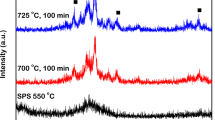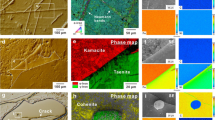Abstract
IT is generally accepted that the lattice parameter of retained austenite in quenched iron—carbon alloys increases continuously and linearly with the increase of carbon content. So far, however, the presence of retained austenite has only been recognized when the iron—carbon alloy contains more than 0·6 per cent of carbon1.
This is a preview of subscription content, access via your institution
Access options
Subscribe to this journal
Receive 51 print issues and online access
$199.00 per year
only $3.90 per issue
Buy this article
- Purchase on Springer Link
- Instant access to full article PDF
Prices may be subject to local taxes which are calculated during checkout
Similar content being viewed by others
References
Epstein, S., "The Alloys of Iron and Carbon", vol. 1, "Constitution" (New York, McGraw-Hill Book Co., Inc., 1936).
Wrazej, W. J., Nature, 158, 308 (1946).
Wrazej, W. J., J. Iron and Steel Inst. (July 1946).
Dannatt, C. W., and Wrazej, W. J. (in preparation).
Author information
Authors and Affiliations
Rights and permissions
About this article
Cite this article
WRAZEJ, W. Lattice Spacing of Retained Austenite in Iron—Carbon Alloys. Nature 163, 212–213 (1949). https://doi.org/10.1038/163212a0
Issue Date:
DOI: https://doi.org/10.1038/163212a0
This article is cited by
-
The behaviour of stacking fault energy upon interstitial alloying
Scientific Reports (2017)
-
The C-Fe (carbon-iron) system
Journal of Phase Equilibria (1992)
-
Spacings of Retained Austenite in Quenched White Cast Iron
Nature (1950)
-
Lattice Parameters of Martensite and of Austenite
Nature (1950)
Comments
By submitting a comment you agree to abide by our Terms and Community Guidelines. If you find something abusive or that does not comply with our terms or guidelines please flag it as inappropriate.



